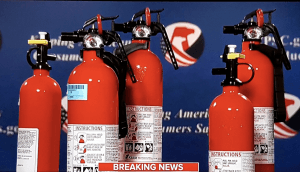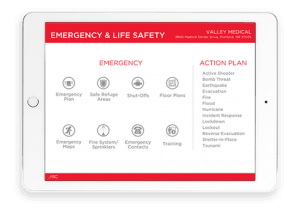Safety Alert
Responding to a Fire Extinguisher Mass RecallYesterday, the United States Consumer Product Safety Commission (CPSC) announced a mass recall of nearly 40 million plastic handle fire extinguishers and push-button Pindicator fire extinguishers in the United States.
The CPSC released the following statement:
The fire extinguishers can become clogged or require excessive force to discharge and can fail to activate during a fire emergency. Additionally, the nozzle can detach with enough force to pose an impact hazard.

The CPSC’s release says that the faulty extinguishers have caused one death, 16 injuries and 91 instances of property damage. The recall involves 134 models of Kidde fire extinguishers that were manufactured between January 1973 and August 2017.
With the large volume of extinguishers being recalled, how is it possible to account for every fire extinguisher? Fire extinguishers are located in businesses, consumers, schools, hospitals across the nation---identifying every faulty fire extinguisher is a monumental undertaking.
How the Recall Works — And Best Practices for Facilities Moving Forward
Kidde, the product manufacturer is offering to replace the faulty fire extinguishers with their new, metal handle extinguishers free of charge. This is easy enough to do if you only have a few extinguishers.
But if you run a large building or multiple buildings in spread out locations, you’ll have to pay someone to walk each building and every floor to determine which extinguishers are being recalled. Figuring out which fire extinguishers are faulty will be a nightmare.
For facility managers and building owners, these hazards can’t be ignored. But how can you solve this problem? To help you with emergency preparedness, we’ll review the steps you need to take to replace your Kidde fire extinguishers.
1. Identify whether or not your fire extinguisher is faulty. 
There were two types of fire extinguishers that were recalled: a push-button model and a plastic handle model. According to Kidde, the push-button model is mostly used for “kitchen and personal watercraft applications,” but that doesn’t mean anyone should let their guard down.
Kidde has provided informational guides on both types or products to help you identify if your extinguisher needs to be replaced.
Is There Any Solution for the Same?
If you’re a facility manager or a building owner, there is technology available to make this process much easier. We recently launched an Emergency and Life Safety facility dashboard that can make extinguisher model and serial numbers searchable. Rather than you needing to manually check each extinguisher, this technology enables instant visibility of extinguisher location and any product information, such as serial or model number.
2. Request a new Kidde fire extinguisher.
Simply fill in your contact details on Kidde’s website and they’ll take care of the rest. There are two forms—one for each type of product. The plastic handle product recall form and the push-button product recall form are available on Kidde’s website.
3. Ensure that every extinguisher in your facility is replaced.
Because of the hazards involved and to be prepared with an emergency response before time, you’ll want to double and triple check that no faulty extinguishers are left in your building(s). Again, facilities software makes this task easy. Without the benefit of technology, though, you’ll need to have someone go through your buildings to ensure all the products in question have been replaced.
If you run multiple buildings in spread out locations, this could be a full-time job for weeks to come.
10, 20 or 200 fire extinguishers and model numbers?
